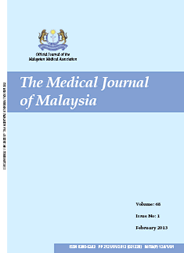MJM, Vol 70 Supplement 1 September 2015
Falciparum malaria outbreak in low transmission
area at Penampang Sabah, Malaysia 2012
*Penampang District Health Office, Sabah, **Disease Control Division, Ministry of Health Malaysia
ABSTRACT
Introduction: Malaria incidence in Penampang is 0.05 per 1000 population and is lowest among districts in Sabah. On June 26th 2012, the primary health clinic was notified of two malaria cases from village K. The aim of this study was to identify the risk factor associated with the outbreak and to institute control measures.
Methods: We visited all 79 houses in the village to search for cases. A case control study with a ratio of 1:4 was conducted. Participants were interviewed using self-administered questionnaire. Cases were defined as any person in K village with malaria parasites present in blood smear with or without malaria symptoms whereas control is negative results. The microscopic examination and entomology sampling was carried out by trained technicians.
Results: Eleven of 470 persons met the case definition. Nine cases was detected from active case finding and one died due to cerebral malaria. The incidence was higher among 11-20 years old, males, and rubber tappers. The outbreak started on 28 May 2012 and peaked a month later. Odds of cases who live nearby stagnant water is 7.3 times (Odds Ratio 7.3, 95% CI: 1.2-43.5). All cases were positive for Plasmodium Falciparum with a gametocyte rate of 55%. Anopheles Balabacensis sp mosquitoes was detected. Mosquito larvae were found in stagnant water and buffalo’s footprints. Rubber cultivation activity had created influx of foreign workers for land clearing.
Conclusion: This Plasmodium Falciparum outbreak was due to imported parasite from foreign workers and introduced to community via Anopheles Balabacensis. Passing near stagnant water bodies was the risk factor. Integrated vector management, screening, social mobilisation and campaign have been instituted to control the outbreak. Cooperation needed from agriculture authority and landowner to prevent future outbreak.
Keywords: Plasmodium Falciparum, Anopheles Balabacensis, foreign workers.
